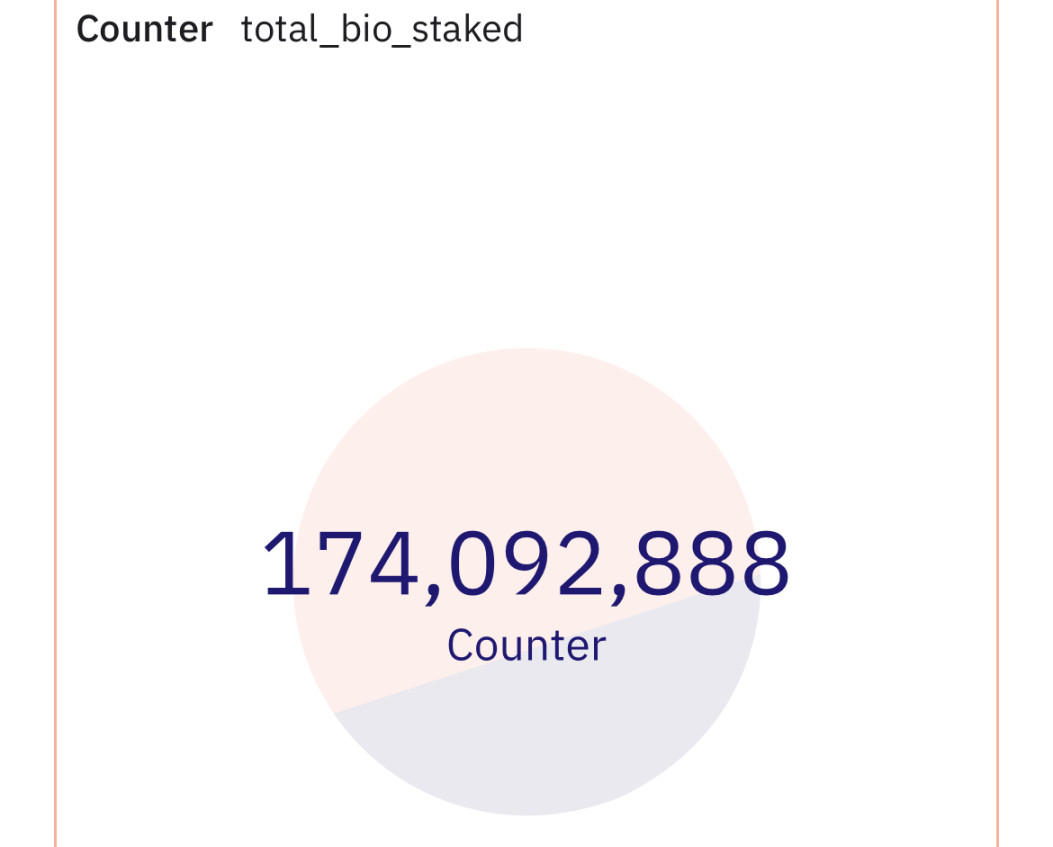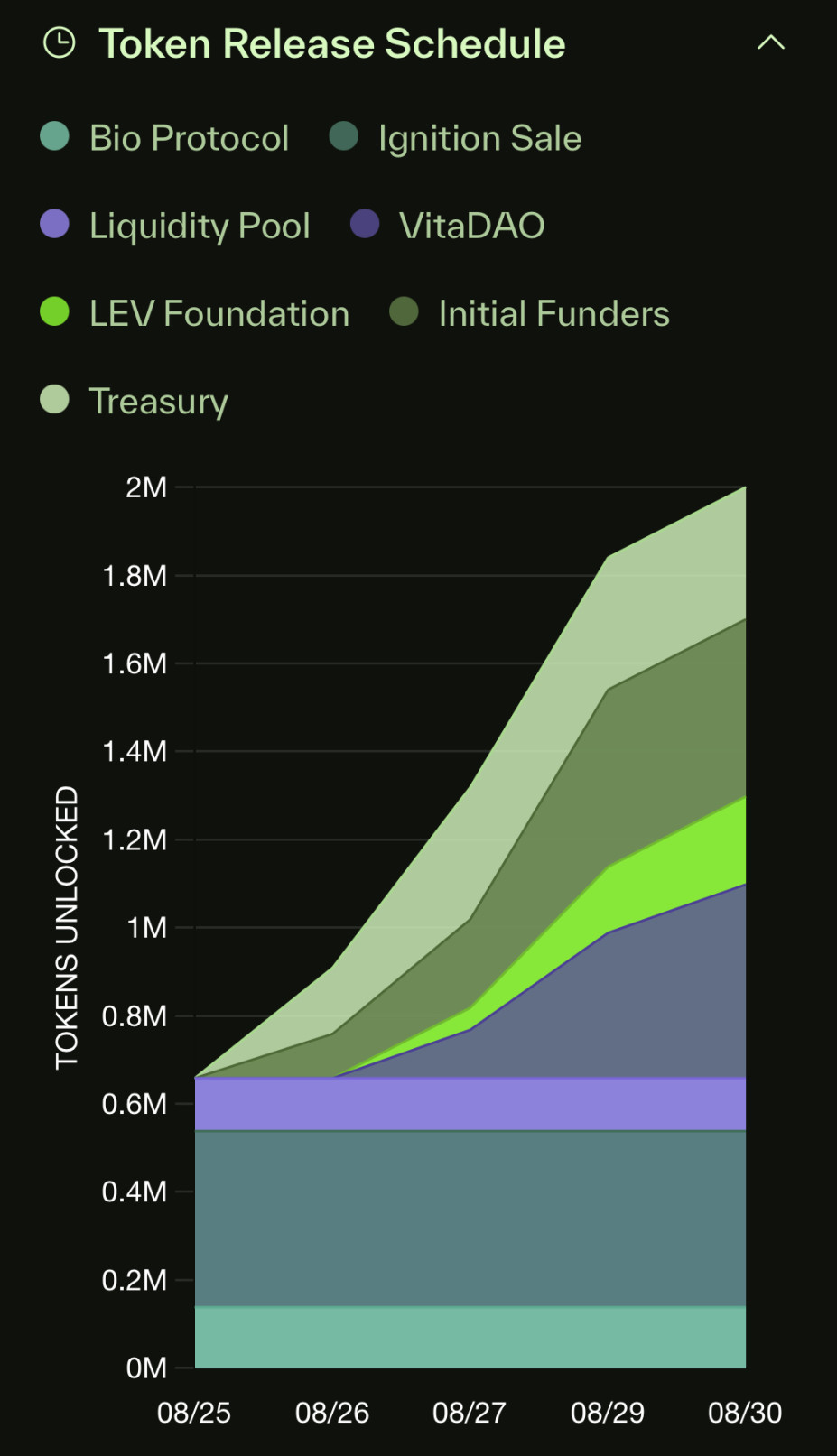BIO continues to rise, can longevity AI agents help DeSci recover?
The BIO token from Bio Protocol has recently stood out with remarkable price action. Bitget data shows that BIO’s price began at $0.056 on August 6, 2025, rising steadily to a peak of $0.2081 by August 22, 2025—an increase of over 270% during this period.

Currently, about 174 million BIO tokens are staked, representing roughly 9.3% of the total circulating supply of 1.854 billion tokens. BIO is listed on several leading exchanges, including Binance, Coinbase, and Bithumb.
At the end of 2024, the DeSci boom lasted only a few months. After BIO was listed on Binance, its price performance was widely described as “disastrous”—after reaching an all-time high of $0.8, it steadily declined, hovering near $0.05 until August 2025, a drop of over 90% from its peak. So, what sparked BIO’s revival?
Looking back, on November 8, 2024, Binance Labs (now YZi Labs) announced its investment in Bio Protocol. While the investment details were not disclosed, this move highlighted mainstream capital’s recognition of the DeSci sector.
As a flagship DeSci project, Bio Protocol’s central goal is to “transform the funding and commercialization models of early-stage biotechnology research” through a biotechnology DAO network.
Leveraging blockchain technology, the platform empowers scientists, patients, and investors worldwide to jointly participate in new drug development, tackling the traditional challenges of capital concentrated among major pharmaceutical companies and restricted research outcomes. It enables global stakeholders to fund and collaborate on next-generation therapeutics, especially for rare diseases, longevity research, and emerging health issues.
On June 3, 2025, DeSci project token PYTHIA began a strong rally, rising from $0.0168 to $0.122 by August 14, 2025—a 626% increase.
On July 31, 2025, Coinbase simultaneously listed BIO and RSC, two DeSci project tokens, marking DeSci’s renewed presence in mainstream Western digital asset markets.
Since then, DeSci project VitaDAO’s token VITA rose from $1.17 on August 1 to a high of $2.22 on August 22—a total gain of 89%. Cerebrum DAO’s NEURON token also performed exceptionally well in August, gaining over 180% for the month. Meanwhile, CryoDAO’s CRYO token rose over 200%. ValleyDAO’s GROW climbed 76%. HairDAO’s HAIR increased by 67.5%. These data indicate a resurgence in the DeSci sector.
Aubrai: How AI Scientists Are Transforming Longevity Research
In 2025, Bio Protocol ramped up its innovation cycle. On August 21, Bio Protocol and VitaDAO jointly launched Aubrai as the inaugural project under their BioAgent Launch initiative, signaling the formal debut of their “decentralized research agents” strategy. The sale lasted just 24 hours, and users participated by staking BioXP and committing BIO tokens. The AUBRAI token generation event (TGE) is set for August 25.

Bio Protocol released AUBRAI’s tokenomics, which include a total supply of 2 million tokens: 20% for sale, 6% to the liquidity pool, 15% to the treasury, 20.1% to initial supporters, 10% to the LEV Foundation, 22% to VitaDAO, and 6.9% to Bio Protocol.
Aubrai was developed using proprietary laboratory data from longevity research pioneer Dr. Aubrey de Grey. He introduced the “Strategies for Engineered Negligible Senescence (SENS),” a methodology aimed at preventing age-related diseases by repairing cellular damage. Dr. de Grey holds a bachelor’s in computer science and a doctorate in biology from the University of Cambridge, and is the author of books including “Mitochondrial Free Radical Theory of Aging” (1999) and “Ending Aging” (2007).
He currently serves as President and Chief Science Officer of the LEV Foundation, which focuses on longevity research. Its main “Robust Mouse Rejuvenation” project, in partnership with Ichor Life Sciences, uses large-scale mouse lifespan experiments to test late-stage therapeutic interventions. The research prioritizes damage-repair strategies and avoids early interventions like gene editing, accelerating translation to human clinical applications.
Another LEV Foundation initiative, “Transplants on Demand,” advances tissue engineering and funds cryopreservation technology developed by Keinice Bio, which uses ultracold helium gas to vitrify organs. This method avoids the toxicity of traditional cryoprotectants, aiming to provide “off-the-shelf” young organs to address age-related organ failure.
LEV Foundation also supports the Alliance for Longevity Initiatives, a 501(c)(4) nonprofit that advocates for U.S. government support for longevity research. By collaborating with field experts, the foundation works to raise awareness of chronic age-related diseases and secure federal funding at the national level.
Through this body of research, Dr. de Grey’s laboratory has amassed thousands of unpublished research notes, experimental data, and collective longevity knowledge worldwide. Previously reserved for internal use, these “private research assets” are now consolidated as training data for Aubrai.
In practice, Aubrai has already transformed de Grey’s team workflow, managing over ten complex longevity research projects and reducing manual review cycles from weeks to days. It identifies dosage conflicts, scheduling mismatches, and hidden biases. Sometimes it uncovers issues previously missed by the team.
According to the official roadmap, Aubrai has secured joint funding from Bio Protocol and VitaDAO for the RMR2 pilot study, which aims to validate candidate interventions and optimize dosing strategies. Community scientists can access Aubrai’s collaborative features as “co-scientists” via a closed beta chat UI. Additionally, wallet support is provided using the Coinbase Developer Platform, enabling self-custodial EOA wallets with restricted transaction permissions.
Aubrai will release semi-autonomous agents in Q4 2025 (integrating Base AgentKit for full transaction execution and financial autonomy). The FAILURE DB database—a registry for negative results and design flaws to prevent repeated errors—will also be opened. This will pave the way for fully autonomous research, including hypothesis generation, experimental design, laboratory execution, and publication.
V2 Upgrade: Creating an Efficient Research/Capital Cycle
Aubrai’s deployment was made possible by the support of Bio Protocol V2. The upgraded version adopts a “launch and grow” paradigm, driving sustainable growth with community-powered launchpads:
- Low-valuation launches: Inspired by models like Pump.fun, initial project valuations are set as low as $205,000 FDV, with 37.5% of tokens sold directly. Each user can purchase up to 0.5% of total sale tokens;
- Sustainable liquidity: All funds raised (BIO tokens) are automatically converted into an LP pool alongside 12.5% of the total supply. Each secondary-market transaction incurs a 1% fee (70% to the project treasury, 30% to the protocol), creating a feedback loop of “trading activity — increased research funding — accelerated results — renewed market interest”;
- Points-based incentives: Users earn BioXP points for staking, governance voting, community engagement, and participating in new launch events; points can be redeemed for allocations in future projects with low initial valuations.
These mechanisms have transformed Bio Protocol from a “scientific research funding platform” to a “scientific research ecosystem OS”—solving capital problems while improving conversion efficiency of research outcomes through both community incentives and automation.
DeSci’s Long-Termism and Its Future
BIO’s market rebound and Aubrai’s launch have thrust the DeSci sector back into the public spotlight. Still, persistent challenges remain: research cycles are long (even with Aubrai’s acceleration, longevity therapies take years to move from lab to clinic), the market’s patience is short (crypto investors are accustomed to rapid gains and losses), and regulatory uncertainty persists (human subject research carries significant compliance costs).
Binance founder Changpeng Zhao said in a Foresight News interview: “DeSci and meme coins are two extremes. DeSci projects have long lifecycles, but crypto investors typically have short attention spans. Meme coins are all the rage, so projects like this get overlooked. Yet in the long run, these projects can have huge benefits for humanity and society. I’m confident they’ll eventually take off, but it’s impossible to say exactly when.”
Disclaimer:
- This article is republished from [Foresight News], with copyright retained by the original author [Nicky, Foresight News]. If you have concerns about this republication, please contact the Gate Learn team for prompt action in accordance with relevant procedures.
- Disclaimer: The views and opinions presented are those of the author alone and do not constitute investment advice.
- Other language versions of this article have been translated by the Gate Learn team. Without explicit mention of Gate, it is prohibited to reproduce, distribute, or plagiarize any translated version.
Related Articles

Solana Need L2s And Appchains?

The Future of Cross-Chain Bridges: Full-Chain Interoperability Becomes Inevitable, Liquidity Bridges Will Decline

Sui: How are users leveraging its speed, security, & scalability?

Navigating the Zero Knowledge Landscape

What Is Ethereum 2.0? Understanding The Merge
